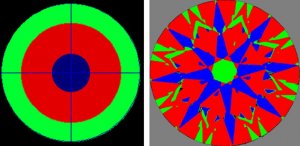JohnQuixote
Ideal_Rock
- Joined
- Sep 9, 2004
- Messages
- 5,212
Well, tie me kangaroo down, sport...No way!Date: 11/21/2004 5:40:42 AM
Author: Garry H (Cut Nut)
John were you drinking when you posted this - not sure if you were doing a Star Trek joke - or being serious?

*Mom, if you're reading this, don't listen to Garry.

Okay, seriously, let me reference your prior post:
<BR class="ibbquote"Date: 11/19/2004 95:47 PM
Author: Garry H (Cut Nut)
I agree with Rhino - but yes - they will use the same approach - the ASET scope will show more green in the returned light.
So...At IDCC the Sasian/Yantzer/Caudill discussion of angular spectrum (Proceedings page 16-17) used practical examples for RB. The color coding (fig 2) represents angular rays arriving from H to 45 degrees as Green, 45 to 75 degrees as red and 75 to vertical as blue.
As to my question: Referencing AGS "Making The Cut," page 19, the example of a Princess (confirming ASET with DiamCalc) shows contrast of a typical princess cut. There is an abundance of green in the returned light - as you noted - and I was wondering if, as with the IDCC presentation's example of a RB, the green angular rays are those arriving from H-45. Or am I on a different page?
PS - I am now drinking as I post this, but it's all Starbucks, baby.













300x240.png)